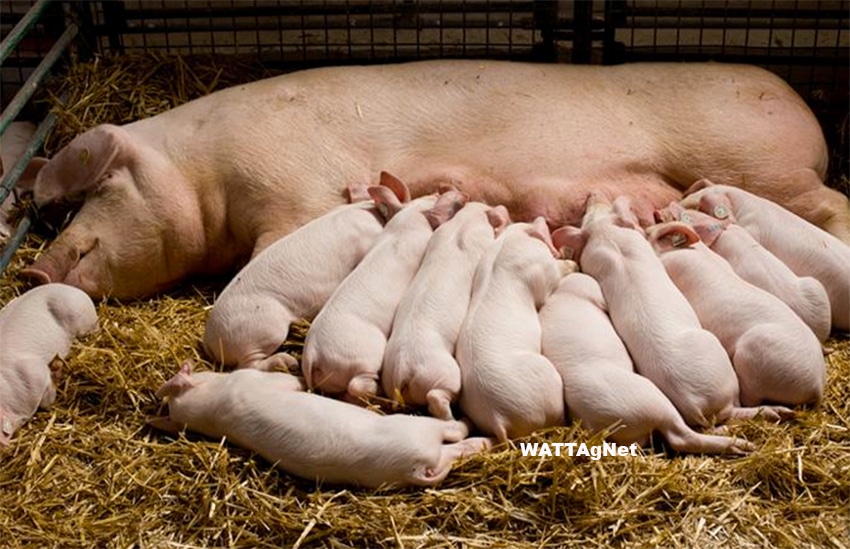Gareth Salmond (MSc Animal Nutrition, Pr. Sci. Nat.) is the Divisional Technical Manager for swine at Meadow Feeds. For more information contact him at Gareth.Salmond@meadowfeeds.co.za
Selection for larger litter sizes has resulted in a challenge for farm management due to the indirect reduction to piglet birth weight and the increased competition amongst littermates.
The continued drive for improving sow performance means we should begin feeding more closely to the complexity of sow physiology and the rapid changes in nutrition which this brings. We believe that assisting sows to reach their genetic potential requires increased attention to detail during the transition phase from gestation to lactation, as well as from the wean-to-oestrus phase.
Emphasis on these phases will assist to increase sow longevity and reduce piglet mortality.
Gestation feeding and the importance of body condition
For sows or gilts to transition effectively, their management and feeding during gestation is essential. Important traits such as number of piglets born alive, individual piglet birth weight, and colostrum and milk production are all influenced during gestation and can be influenced as early as the wean to oestrus period. The goals of gestation feeding include the following:
- To meet maintenance requirements of sows or gilts, along with any growth or weight gain requirements.
- To supply sufficient nutrients for embryo development.
- To manage sow or gilt body condition.
Overfed sows or gilts which enter farrowing over-conditioned can result in a higher incidence of farrowing complications, higher stillbirth percentage and higher incidence of lameness. Research at Kansas State University indicated that fatter sows at farrow had lower feed intake during lactation, lost more body reserves and were less prolific during the subsequent parity.
Under-conditioned sows or gilts at farrowing will compromise the sows’ body reserves for milk production and persistency during lactation, compromise mammary gland development, may compromise piglet birth weight and predispose sows to subsequent reproductive failure. Some important aspects to remember for gestation feeding include:
- The feeding curve will depend on the body condition losses experienced during lactation.
- The first 45 days of gestation represent the best opportunity for replenishing the body reserves of sows, before the foetal growth demand is increased.
- The feeding curve will depend on the composition of the diet, density of the diet and amount and type of fiber included to the diet.
Sows have become more efficient at utilising nutrients, which has created a more cautious approach to late gestation feeding to avoid unnecessary body weight gain.
Even though a sow will prioritize nutrients towards their litter growth, emphasis is still required to adequately supply the sow during late gestation to meet the accelerated foetal and mammary development, whilst ensuring sufficient available body reserves when entering farrow.
Feeding increased fiber during gestation can help address sow welfare issues by reducing stress and increasing satiety levels, reduce over-conditioning of sows and enhance feed intake in lactation due to increased gut capacity, thereby improving productivity.
Transition from gestation to lactation
Research on transition sows has focused on increasing piglet birth weights, shortening the farrow duration to reduce stillbirths and improving colostrum composition and yield.
The goal during the transition period from gestation to lactation is to supply the correct nutrients for a rapid foetal and mammary growth, assist the farrowing process and transition the sow onto lactation feed. The transition period is very stressful for sows, creating an environment where sows are prone to health complications and locomotive injuries.
The effort and costs placed into the gestation period is only paid off during lactation, whilst attention to detail in the transition period can be helpful in achieving the desired results.
The advantage of a transition diet allows application of functional feed ingredients to support the farrowing sow. Careful consideration is to be given to the digestible amino acid supply, cation-anion balance and mineral mobilisation, liver function and dietary energy sources, including fermentable fiber. Consideration of the dietary fiber level and source are encouraged for their influence on:
- Increased passage rate, leading to reduced constipation.
- Increase of slow release energy for an improved and shorter farrow process.
- Increased lipid content of colostrum, which in addition to dietary fat level and source, may be another way to improve energy transfer to the newly born piglet.
Research has shown that sows fed substantial fiber amounts are still able to absorb energy from the gastro intestinal tract 24 hours after their last meal, indicating the importance for sows entering the farrow process after a period of poor appetite.
Transition into lactation
Supporting a larger litter size has considerably increased the nutritional requirements of sows during lactation. However, the genetic improvements in sow performance have not been accompanied by a proportional increase in feed intake, which is where emphasis on nutrition becomes important.
The goal in lactation is for sows to start eating well and to maintain high feed intakes throughout lactation. The increased adoption of ad lib feeders has assisted with this, although further attention to detail during early lactation feeding can assist sows in maintaining a good appetite throughout lactation.
The motivation for achieving this exists in the reduction of body condition loss, improved weaning weights, decreased pre-weaning mortality and ensuring subsequent reproductive performance.
Research has repeatedly shown that too restrictive feeding patterns during early lactation for the reduction of sow complications can reduce total lactation feed intake; whilst too aggressive feeding curves can negatively affect appetite.
These problems can be addressed by using a strict strategy of feeding during the transition and early lactation periods. Practical tips for maintaining appetite include:
- Maintaining a well-balanced, palatable and fresh feed.
- Careful attention to daily feed allowance.
- Supply of fresh, cold water at a flow rate of 2 litres/minute or greater.
- Feeder design should support high feed intakes.
- 10-12 hours of lighting, along with a comfortable sow environment.
- Catching and treating sick sows early.
Concluding remarks
The same reproductive cycle feeding programme may have different results on different farms due to differences in farm environment, genetics and management. Using a farm specific nutritional strategy during the transition period from gestation to lactation, will help raise sow performance to the next level. Ultimately management and feeding should aim for a quick and healthy recovery by the sow after parturition, accompanied by a fast and sustained increase in feed intake.
*References are available on request.
The South African Pork Producers’ Organisation (SAPPO) coordinates industry interventions and collaboratively manages risks in the value chain to enable the sustainability and profitability of pork producers in South Africa.









